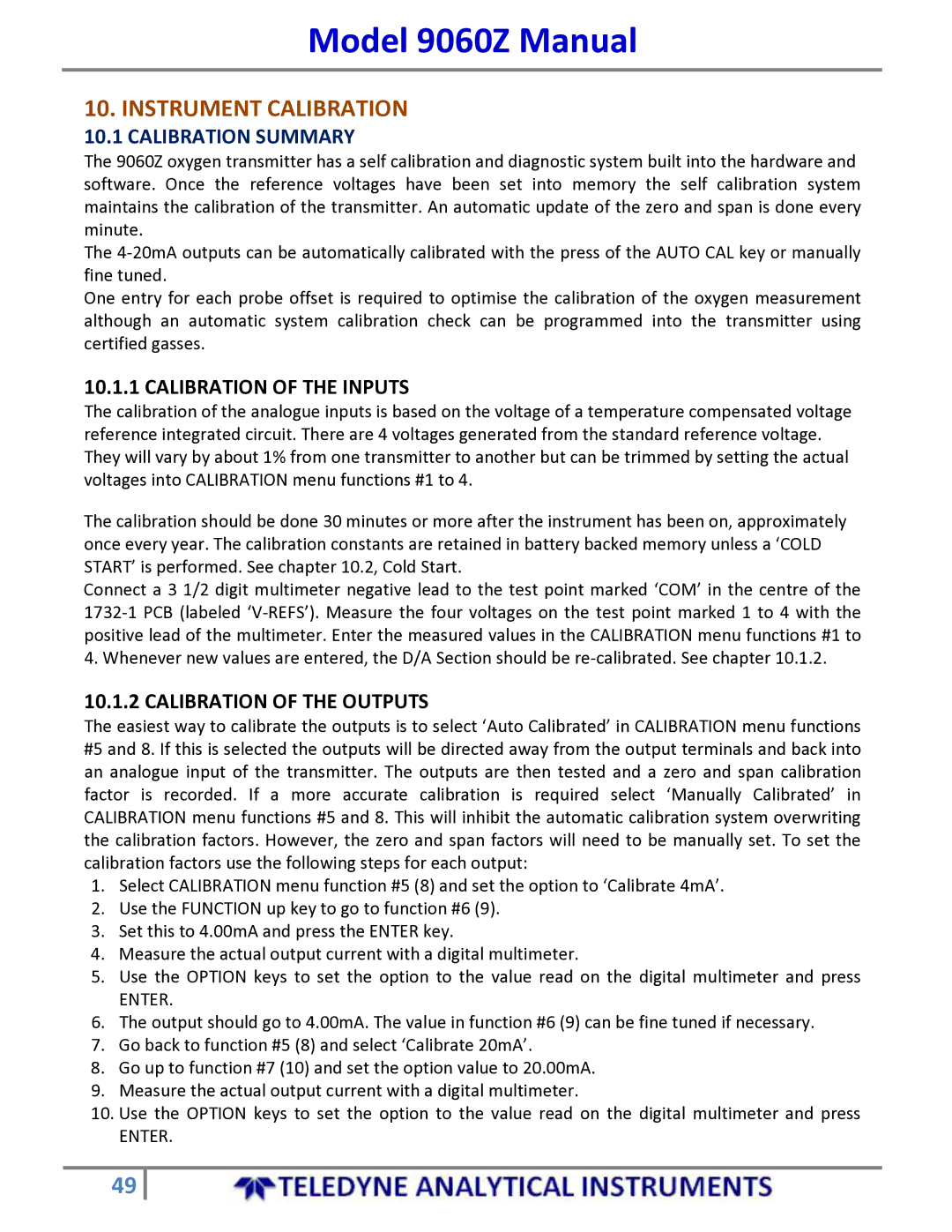
Model 9060Z Manual
10. INSTRUMENT CALIBRATION
10.1 CALIBRATION SUMMARY
The 9060Z oxygen transmitter has a self calibration and diagnostic system built into the hardware and software. Once the reference voltages have been set into memory the self calibration system maintains the calibration of the transmitter. An automatic update of the zero and span is done every minute.
The 4‐20mA outputs can be automatically calibrated with the press of the AUTO CAL key or manually fine tuned.
One entry for each probe offset is required to optimise the calibration of the oxygen measurement although an automatic system calibration check can be programmed into the transmitter using certified gasses.
10.1.1 CALIBRATION OF THE INPUTS
The calibration of the analogue inputs is based on the voltage of a temperature compensated voltage reference integrated circuit. There are 4 voltages generated from the standard reference voltage. They will vary by about 1% from one transmitter to another but can be trimmed by setting the actual voltages into CALIBRATION menu functions #1 to 4.
The calibration should be done 30 minutes or more after the instrument has been on, approximately once every year. The calibration constants are retained in battery backed memory unless a ‘COLD START’ is performed. See chapter 10.2, Cold Start.
Connect a 3 1/2 digit multimeter negative lead to the test point marked ‘COM’ in the centre of the 1732‐1 PCB (labeled ‘V‐REFS’). Measure the four voltages on the test point marked 1 to 4 with the positive lead of the multimeter. Enter the measured values in the CALIBRATION menu functions #1 to 4. Whenever new values are entered, the D/A Section should be re‐calibrated. See chapter 10.1.2.
10.1.2 CALIBRATION OF THE OUTPUTS
The easiest way to calibrate the outputs is to select ‘Auto Calibrated’ in CALIBRATION menu functions #5 and 8. If this is selected the outputs will be directed away from the output terminals and back into an analogue input of the transmitter. The outputs are then tested and a zero and span calibration factor is recorded. If a more accurate calibration is required select ‘Manually Calibrated’ in CALIBRATION menu functions #5 and 8. This will inhibit the automatic calibration system overwriting the calibration factors. However, the zero and span factors will need to be manually set. To set the calibration factors use the following steps for each output:
1.Select CALIBRATION menu function #5 (8) and set the option to ‘Calibrate 4mA’.
2.Use the FUNCTION up key to go to function #6 (9).
3.Set this to 4.00mA and press the ENTER key.
4.Measure the actual output current with a digital multimeter.
5.Use the OPTION keys to set the option to the value read on the digital multimeter and press
ENTER.
6.The output should go to 4.00mA. The value in function #6 (9) can be fine tuned if necessary.
7.Go back to function #5 (8) and select ‘Calibrate 20mA’.
8.Go up to function #7 (10) and set the option value to 20.00mA.
9.Measure the actual output current with a digital multimeter.
10.Use the OPTION keys to set the option to the value read on the digital multimeter and press
ENTER.
49
